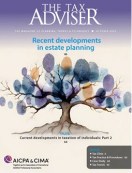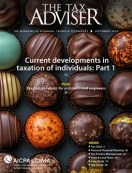- tax clinic
- procedure & administration
Listing of reportable transactions under the APA
Related
IRS clarifies how employees can claim 2025 tip and overtime deductions
AICPA warns that merger of IRS offices would ‘confuse’ taxpayers
Is the IRS just between shutdowns? Former IRS commissioners are worried
TOPICS
Editor: Alexander J. Brosseau, CPA
Just over two decades ago, the IRS and Treasury issued regulations to facilitate the identification and handling of potentially abusive transactions (Regs. Sec. 1.6011-4, first issued in T.D. 9046 and subsequently in T.D. 9350). This regulation created six categories of “reportable transactions”: (1) listed transactions, (2) confidential transactions, (3) transactions with contractual protection, (4) loss transactions, (5) transactions with a significant book-tax difference, and (6) transactions involving a brief asset holding period. Today, reportable transactions include the first four categories noted above and a fifth category, which the IRS refers to as “transactions of interest.”
A listed transaction is a transaction that is the same as, or substantially similar to, a transaction that the IRS has determined to be a tax-avoidance transaction and that has been identified in a notice, regulation, or other form of published guidance as a listed transaction (Regs. Sec. 1.6011-4(b)(2)). Currently, 36 listed transactions are in effect, with three additional transactions in proposed form. Of the 36 transactions that have already been listed, 28 of these were listed via IRS notice.
At the end of 2022, following a number of taxpayer-favorable court decisions, the IRS started identifying listed transactions through the issuance of proposed regulations. It is important for tax practitioners to understand these reportable-transaction rules because various penalties under Secs. 6662A, 6707, 6707A, and 6708 could apply to taxpayers or material advisers who fail to comply with these rules. Additionally, failure to disclose listed transactions could affect the assessment period of limitation pursuant to Sec. 6501(c)(10). This item discusses the case law that has resulted in the IRS and Treasury’s changing how they list transactions and the implications for tax practitioners going forward.
Mann Construction
In fall 2007, the IRS issued Notice 2007-83, Abusive Trust Arrangements Utilizing Cash Value Life Insurance Policies Purportedly to Provide Welfare Benefits. Notice 2007-83 identified as listed transactions certain trust arrangements claiming to be welfare benefit funds and involving cash-value life insurance policies that were promoted to and used by taxpayers to improperly claim federal income and employment tax benefits. As with all listed transactions, the listing notice also served to inform taxpayers of their obligation to report their participation in the transaction with their tax return and to the Office of Tax Shelter Analysis by filing Form 8886, Reportable Transaction Disclosure Statement, as well as for material advisers to file Form 8918, Material Advisor Disclosure Statement, and comply with list maintenance requirements.
In 2013, Mann Construction, a Michigan-based general contractor jointly owned by two shareholders, established an employee benefit trust that paid premiums on cash-value life insurance policies benefiting the owners. Under Notice 2007-83, this arrangement was a listed transaction and reportable on Form 8886. However, the taxpayers disclosed their participation on Forms 8275, Disclosure Statement, instead of Form 8886.
On May 9, 2019, the IRS disallowed the deductions that Mann Construction took in connection with the trust arrangement and assessed Sec. 6707A penalties against both the contractor and its shareholders for failure to disclose participation in a listed transaction on Form 8886. The taxpayers paid the Sec. 6707A penalties for 2013 and filed Forms 843, Claim for Refund and Request for Abatement, requesting refunds of the amounts paid. Following the disallowance of the claims for refund, the taxpayers filed a refund suit in the District Court for the Eastern District of Michigan.
In their complaint, the taxpayers alleged that Notice 2007-83 violated the Administrative Procedure Act (APA). Specifically, they alleged that Notice 2007-83 (1) was an “unauthorized agency action” (Count I); (2) was “arbitrary and capricious” (Count II); (3) was improperly issued without public notice and comment (Count III); and (4) that the trust arrangements were not a listed transaction or substantially similar to one (Count IV). The court dismissed Counts I, II, and IV following the government’s motion to dismiss.
Following the dismissal of Counts I, II, and IV, the only issue before the court was whether the IRS had been required to provide public notice and an opportunity for comment before promulgating Notice 2007-83. The district court ultimately ruled that “Congress authorized the IRS to promulgate IRS Revenue Notice 2007-83 without notice and comment” (Mann Construction, Inc., 539 F. Supp. 3d 745, 763 (E.D. Mich. 2021)). The taxpayers appealed the district court’s ruling to the Sixth Circuit.
The appeals court overturned the district court’s decision and held that the IRS was required to follow the APA when identifying listed transactions for purposes of assessing Sec. 6707A penalties (Mann Construction, Inc., 27 F.4th 1138 (6th Cir. 2022)). Specifically, the Sixth Circuit concluded that Notice 2007-83 was a legislative rule that created a substantive duty to report a specific type of transaction and that no express language exempted the IRS from complying with the APA (id. at 1143–48).
Under the APA, as interpreted by the holding in Mann, the IRS is required to (1) publish a notice of proposed rulemaking; (2) allow for public comment; (3) consider the comments, making appropriate changes where necessary; and (4) include a “concise general statement of ” the final rule’s contents (citing Perez v. Mortgage Bankers Association, 575 U.S. 92, 96 (2015)).
Subsequent case law applying Mann
Following the analysis of the Sixth Circuit in Mann, the District Court for the Eastern District of Tennessee held that Notice 2016-66, which identified microcaptive transactions as transactions of interest, was a legislative rule that was invalid because the IRS had failed to follow the APA’s notice-and-comment procedures (CIC Services, LLC, 592 F. Supp. 3d 677 (E.D. Tenn. 2022)). Following the rationale in Mann, the Tax Court also set aside Notice 2017-10, which identified all syndicated conservation easement transactions as listed transactions, reasoning that the notice failed to comply with the APA’s notice-and-comment requirements (Green Valley Investors, LLC, 159 T.C. 80 (2022)). Similarly, the District Court for the Northern District of Alabama set aside Notice 2017-10 (Green Rock, LLC, No. 2:21-cv-01320-ACA (N.D. Ala. 2/2/23)).
IRS’s response to taxpayer-favorable decisions
At the end of 2022, the IRS released Announcement 2022-28, in which it addressed why it was issuing proposed regulations to identify certain syndicated conservation easement transactions as listed transactions:
The Department of the Treasury … and the IRS disagree with the Tax Court’s decision in Green Valley and the Sixth Circuit’s decision in Mann Construction, and are continuing to defend the validity of existing listing notices in circuits other than the Sixth Circuit. At the same time, however, to eliminate any confusion and to ensure that these decisions do not disrupt the IRS’s ongoing efforts to combat abusive tax shelters throughout the nation, the Treasury Department and the IRS are today issuing proposed regulations to identify certain syndicated conservation easement transactions as listed transactions. The Treasury Department and the IRS intend to finalize these regulations, after due consideration of public comments, in 2023 and intend to issue proposed regulations identifying additional listed transactions in the near future.
While the proposed regulations for syndicated conservation easement transactions essentially serve to “relist” these types of transactions following the Tax Court’s holding in Green Valley, Announcement 2022-28 can be more widely interpreted as Treasury and the IRS’s statement that they will list transactions in the future through the issuance of proposed regulations and request public comment.
In 2023, the IRS issued three sets of proposed regulations to identify three additional listed transactions — microcaptive transactions (REG-109309-22), Malta personal retirement schemes (REG-106228-22), and monetized installment sales (REG-109348-22). Microcaptive transactions were previously identified as a transaction of interest (Notice 2017-08, which modified Notice 2016-66). Malta retirement plans and monetized installment sales were both previously placed on the IRS’s Dirty Dozen list.
The notice of proposed rulemaking for microcaptive transactions was published on April 4, 2023, and the public hearing was scheduled for July 19, 2023. The notice of proposed rulemaking for Malta personal retirement schemes was published on June 6, 2023, and the public hearing was scheduled for Sept. 21, 2023. The notice of proposed rulemaking for monetized installment sales was published on Aug. 3, 2023, and the public hearing was scheduled for Oct. 12, 2023. The public hearing for the proposed regulations on microcaptive transactions was held in July as scheduled. However, the public hearings for the proposed regulations on Malta pensions and monetized installment sales were both canceled because no requests to testify were received following the publication of the notices of proposed rulemaking. As of this writing, none of the proposed regulations published consistent with the APA have been finalized.
Implications for tax practitioners
Before the Sixth Circuit’s decision in Mann and the cases that followed, when the IRS sought to list a transaction, the effect of the listing notice was immediate. And with that, so were the disclosure obligations under Secs. 6011 and 6111. Now, however, as the IRS seeks to comply with the APA’s requirements, listing of additional transactions will take months or longer to provide the public sufficient time to comment and to allow Treasury and the IRS to review the comments and make changes as appropriate before issuing final regulations.
Tax practitioners should immediately review the above-referenced proposed regulations and be aware that any clients who have participated in transactions described therein, or substantially similar transactions, may be subject to Form 8886 disclosure requirements as of the date the proposed regulations are finalized. Similarly, any practitioner who is a material adviser with respect to the transaction may have their own disclosure obligations. This potentially includes situations where the tax return was already filed and the period of limitation for assessment of tax has not ended on or before the date the proposed regulations are finalized. Otherwise, taxpayers and practitioners could be subject to penalties and an unlimited assessment period of limitation.
Editor Notes
Alexander J. Brosseau, CPA, is a senior manager in the Tax Policy Group of Deloitte Tax LLP’s Washington National Tax office. For additional information about these items, contact Brosseau at abrosseau@deloitte.com. Unless otherwise noted, contributors are associated with Deloitte Tax LLP.
This article contains general information only and Deloitte is not, by means of this article, rendering accounting, business, financial, investment, legal, tax, or other professional advice or services. This article is not a substitute for such professional advice or services, nor should it be used as a basis for any decision or action that may affect your business. Before making any decision or taking any action that may affect your business, you should consult a qualified professional adviser. Deloitte shall not be responsible for any loss sustained by any person who relies on this article.














